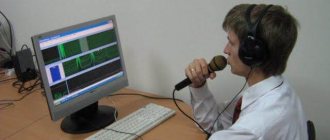Doctors Cost
Price list Doctors clinic
Stuttering is a common pathology in children that can occur for many reasons. It can be congenital or acquired. Often, such a defect causes problems in communication, slows down the child’s personal and intellectual development, and provokes complexes and embarrassment. It is important to understand that treatment of stuttering in children is possible - today there are several proven approaches and advanced treatment methods. The success of treatment depends on how early the pathology is detected and corrective measures are initiated in a timely manner.
What is stuttering
Stuttering, or logoneurosis, is a speech disorder that consists of frequent repetition of individual sounds, syllables or words. Sometimes the patient does not repeat, but lengthens sounds/syllables. Manifestations of stuttering also include frequent stops or “hesitation” of speech.
A child who stutters experiences difficulty when there is a sudden disruption in the function of speech organs and centers during a conversation. The problem can be caused by spasms of the muscles involved in the formation of sounds, as well as the breathing muscles. This leads to the patient suffering from breathing problems and feeling a sudden lack of air.
Games and exercises for voice and pauses
The following complex will help develop the strength and purity of your voice:
- Sounds A and M. Inhale through the nose, pronounce sounds as you exhale;
- Combination of the sound M with vowels. First inhale, then on one exhale: MA, MO, MU, inhale again and another combination: MI, ME, WE. Repeat several times;
- N with vowels. Similar to the previous exercise;
- At one exit we pronounce ZZZZZZZZ - NNYNNNYN. In this case, Zh is the chest sound, Z is the middle sound, Hb is the upper facial sound;
- "True friend". Let the child imagine that his dog ran away. You need to call three times: once as if from afar, then - a little closer and at the end - very close;
- "Fragrance." Let the baby smell the scented handkerchief, and as he exhales say the word “good” - calmly, slowly, syllable by syllable. Then we make it more complicated: we say the phrases “very good”, “smells very tasty”. The same can be done with fruits, flowers and come up with any phrases to pronounce while exhaling;
- "Lullaby". Invite your baby to lull a baby doll, a doll, a soft toy and sing first quietly and then loudly “A-a-a-a-a”;
- "Hurts". We imagine that the tooth hurts and say “O-o-o-o”, alternating the loud and quiet version;
- "Cow". We imitate the moo of an animal, making MMMMMOOOO, varying the strength of the voice.
An always relevant and useful exercise for the development of vocal cords is alternating sounds. While exhaling smoothly after inhaling, we draw out the vowels in any order, for example, “aaaaaaaaaaaaaaaaaaaaaaaaaaaaaaaaaaaaaaaaaaaaaaaaaaaaaaaaaaaaaaaaaaaaaaaaaaaaaaaaaaaaaaaaaaaaaaaaaaaaaaaaaaaaaaaaaaaaaaaaaaaaaaaaaaaaaaaaaaaaaaaaaaaaaaaaaaaaaaaaaaaaaaaaaaaaaaaaaaaaaaaaaaaaaa.
Causes of stuttering
Stuttering can be caused by internal and external reasons. The main congenital factors include the following:
- pathologies during pregnancy of the mother (hypoxia, previous infections, lack of nutrients, etc.);
- birth injuries, premature birth;
- hereditary tendency;
- increased neuro-emotional excitability.
There are more acquired reasons, they can be the following:
- psychotrauma (state of grief and loss, attention deficit, etc.);
- physiological processes - in this case, stuttering goes away when the insufficient maturation of the cerebral hemispheres is compensated after the age of 5;
- past infectious diseases (meningitis, meningoencephalitis, etc.);
- traumatic brain injuries (concussions, brain contusion, etc.).
Childhood stuttering may be false: the child imitates adults who stutter. False stuttering is said to occur when the speech style of a significant adult is copied, but there is no true stuttering.
Symptoms
The main signs of speech impairment are as follows:
- spasms of the speech apparatus when the child pronounces sounds;
- long pauses between spoken sounds;
- repetition of syllables and sounds, words.
However, there are also indirect signs that accompany the main symptoms. These include:
- irritability;
- communication problems, avoidance of communication;
- aggressiveness;
- tearfulness, touchiness.
When diagnosing stuttering in children, the doctor will pay attention to the psychological state. The disease may be accompanied by isolation, refusal to communicate with peers and adults, nervous tics, fears, anxiety, phobias, etc. Sometimes a child suffering from a speech disorder may also suffer from insomnia, decreased appetite, and gastrointestinal dysfunction.
If stuttering is not treated on time, there is a possibility of developing social phobia, nocturnal enuresis and other ailments. Parents must understand that stuttering does not always go away on its own; measures must be taken so that the illness does not leave an imprint on the child’s personality. If corrective measures are refused, children may experience difficulties in building relationships with others, and developmental delays often occur.
Games and exercises to develop speech tempo
The following tasks teach children to recognize fast and slow speech and vary their own tempo. We say at different speeds:
- vowels in any sequence: a-u-o-i-s;
- syllable rows with alternating soft and hard vowels (example: se-sy-su-sa, ze-zyu-zya-zi");
- "Tongue Twisters". For example, “The hedgehog has a hedgehog, the grass snake has a bite,” “The heron, standing on the porch, wrote the letter C.”
Children like fairy tales and tongue twisters and lift their spirits. Choose simpler ones at first, gradually increasing complexity.
Types of stuttering in children
Based on their manifestation, the following forms of stuttering are distinguished:
- tonic: characterized by prolonged pauses, prolongation of vowel sounds;
- clonic: in this case, the child does not pronounce individual letters or syllables;
- combined: this disease is the most complex, it combines the symptoms of both types.
Based on time and consistency of manifestation, three types of stuttering are distinguished:
- stable. It is also called habitual, it appears constantly;
- unstable. Stuttering in this case accompanies stress and situations of heightened emotional background;
- cyclical. This type of stuttering is characterized by periods of calm, when the child speaks calmly, and episodes of stuttering.
Prevention:
Stuttering can be prevented by creating a calm environment. Eliminating factors that can provoke stuttering attacks. Creating a favorable, calm environment. Lack of criticism regarding the child’s speech impediment.
General recommendations for the prevention of logoneurosis in children from 3 to 5 years old
- If a speech defect is detected in a child, you should protect him from anything that can cause emotional stress, including prolonged watching of TV.
- Play classical, relaxing music for your child - its healing effect has long been recognized even by official medicine. The music of Mozart, Beethoven, Grieg, and Chopin has a particularly beneficial effect on the children's psyche.
- You should not rely only on your own strength. Do not hesitate to contact specialists; the faster you can overcome a child’s stuttering, the easier it will be for him to communicate, learn, and explore the world.
- Classes with the child should be systematic. You can't take long breaks.
- Ensure your child sleeps at least 8 hours a day (daytime naps if necessary), and exclude active and computer games in the evening. Limit your time watching cartoons. Thus, the overstrain of the central parts of speech will be reduced.
- Organize proper communication. Talk to your baby calmly, slowly and smoothly, pronouncing all the words. When communicating with your child, try to use questions whose answers are simple and monosyllabic. If your child finds it difficult to pronounce a phrase on his own, say it together.
- Watch your diet. Vegetable and dairy foods should predominate in the diet. You should limit chocolate, sweets, spicy, salty and fried foods.
- Prevention of stuttering in neurologically and mentally healthy children is quite simple and consists of good family relationships. Where there are no conflicts, quarrels, and there is love and understanding, the child has much less risk of becoming a stutterer. Curing stuttering is much more difficult than preventing it. A child’s stuttering sometimes manifests itself so that parents understand their own mistakes.
- You cannot stop stuttering, you can only help, establish mutual understanding and cooperation with the child. And remember that love and faith in the baby’s abilities creates real miracles that even traditional medicine is not always able to explain. Believe in your child and he will succeed.
Recommendations for parents
Treatment of stuttering in children, as well as identification of the causes of speech defects, is carried out by a doctor. But the role of parents in therapy is very important. It is important to behave correctly and follow the following doctor’s recommendations:
- minimizing emotional stress. Avoid aggressive games, listening to loud music, watching TV for long periods of time, or keeping your child at the computer;
- relaxing leisure. Instill in your child a love of classical music and good cartoons, play calm games, read fairy tales, try to get positive emotions and impressions together;
- mode control. Make sure your child gets enough rest and take frequent walks in the fresh air.
A friendly home environment is important at all stages of treatment. It is not recommended to scold the child, shout at him or laugh, or criticize his results if the defect persists at first. It is important to encourage the start of therapy and encourage the baby, encourage him to trust the doctor.
It is very important to maintain a positive atmosphere even after successful correction of stuttering in children. Only in this case can the risk of relapse be minimized.
Expanding your vocal range
The following games for children who stutter help reinforce what they have learned and teach them to vary the intonation and timbre of their voice, which is very important for full speech:
- Count from 1 to 10 at different voice pitches;
- "Motor ship". To the sound U we pronounce the sound of the whistle of 3 ships: large, small and medium in any order;
- Say the phrase “I order you” with different intonations: angry, friendly, indifferent;
- 2 people participate. One says “I will punish you!” with a gradual increase in timbre, and the second says “No” with a decrease.
Any exercises where you need to select different intonation, volume, speed of speech and its emotional coloring are suitable.
Methods and features of stuttering treatment
The question of where to treat stuttering in children worries many parents. It is important to choose a clinic that can implement an integrated approach. The therapy should be carried out by both the primary doctor - a speech pathologist-speech pathologist, and a neurologist, psychologist, if necessary.
The main correction program is compiled by a speech therapist on an individual basis. He will take into account the causes of the defect, age, social environment, and character of the child. Modern approaches are based on normalizing breathing and controlling the rate of speech. Classes are conducted in a favorable atmosphere and in a playful manner. As a rule, the specialist takes an active part in the process - together with the child he reads poetry, sings songs, and trains the speech apparatus with other exercises.
Additional correction methods include:
- massage: allows you to relax, improve blood circulation, relieve muscle spasms;
- breathing exercises: its task is to normalize breathing.
It is possible to work with a physiotherapist and teach gymnastics techniques so that the child can continue to practice at home. Drug therapy is relevant in cases where stress/trauma is the cause of childhood stuttering. The doctor will prescribe medications with a sedative effect. In severe cases, tranquilizers and anticonvulsants may be prescribed. Light drug therapy can accompany basic correction methods. An integrated and, importantly, team approach allows you to get impressive results - improving the condition and eliminating the defect.
For the development of speech breathing
The following games and exercises are necessary to improve diaphragmatic breathing, correct breathing rate and development of the speech apparatus:
- “We breathe well.” The child lies down and places his hand on his upper abdomen. Attention is concentrated on the depth of breathing. We inhale and exhale and notice how the tummy rises and falls;
- "Burst tire." We spread it in front of us like a large tire. As you exhale, slowly say SHSHSHH, while crossing your arms: the right one should be placed on the left shoulder and vice versa. The chest contracts easily as you exhale;
- "Ball". Similar to the previous one, but as you exhale you need to say FFFF;
- "Bug". Your arms should be raised to the sides and slightly pulled back. As you exhale, say ZHZHZH, while lowering your arms;
- "Pendulum". We sit down cross-legged, hands on the back of our heads. First, take a calm breath, then pause for 3 seconds, then bend forward and exhale. When returning to the starting position, inhale;
- "Harvest". From a standing position, raise your arms straight up, as if taking apples from a tree, inhale and hold your breath for 3 seconds. Lower your arms, lean forward and exhale;
- "Harmonic". Starting position: standing straight, hands on your belt. Inhale, then pause for 3 seconds. Tilt to the left - exhale. Repeat on the other side;
- "We warm our hands." We suggest inhaling through your nose and exhaling smoothly through your mouth onto your hands, as if warming them.
For classes with several children, the “Teapot” exercise is suitable. Everyone should be given a jar with a narrow neck. At the signal phrase “Masha’s kettle is boiling,” the named student blows into the opening of the jar so that a whistle is produced. To do this, the exhalation must be very intense, with the lower lip touching the edge of the neck.
Advantages of stuttering treatment at the Family Doctor clinic
The treatment of stuttering in children in Moscow is successfully carried out by specialists from the Family Doctor clinic - speech therapists, speech pathologists, neurologists, psychologists, and psychotherapists.
We offer comprehensive comprehensive diagnostics, accurate identification of the causes of speech defects, and a team approach to solving the problem. Modern equipment with precise, reliable equipment allows us to carry out diagnostics and treatment in a short time. Doctors with many years of experience will provide assistance in cases of any complexity, and will also find an approach to young patients. To make an appointment at a time convenient for you, call the single contact center in Moscow, fill out the online appointment form or contact the clinic reception.
leave feedback
To develop a sense of rhythm
Speech therapy rhythms involve motor exercises that pursue different goals.
Warm-up
Includes various marching to music with changing directions. Helps you get ready for future work.
Normalization of muscle tone
Suitable exercises: freely swing your arms back and forth, to the sides, alternating between tensing and relaxing your arms.
Rhythmization of movements
Walking, clapping and tapping to different musical tempos and rhythms, singing words and syllables are used. Example: clap the song “Cockerel, cockerel, golden comb.”
Effectively use active exercises accompanied by music and speaking of speech tasks. For example, students pronounce the text and accompany it with movements: “Above us is a tall oak tree (arms to the sides), above us are pine trees, spruce trees (tilts left and right), their heads rustled (clap).”






